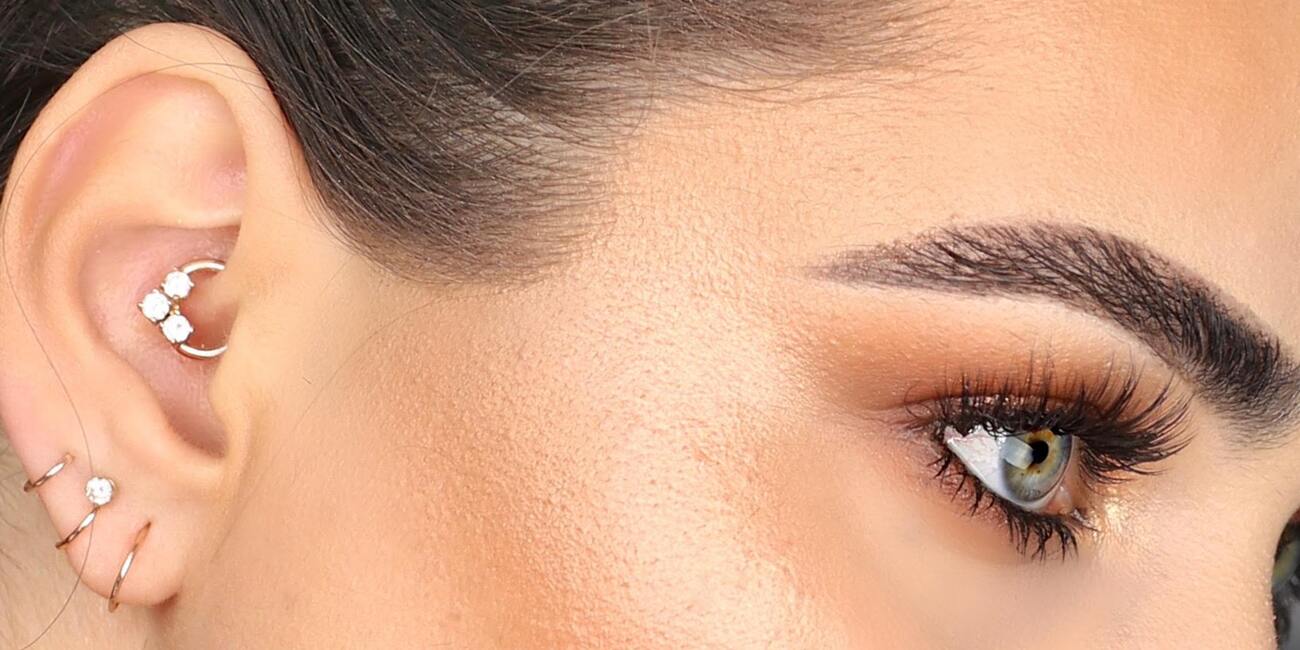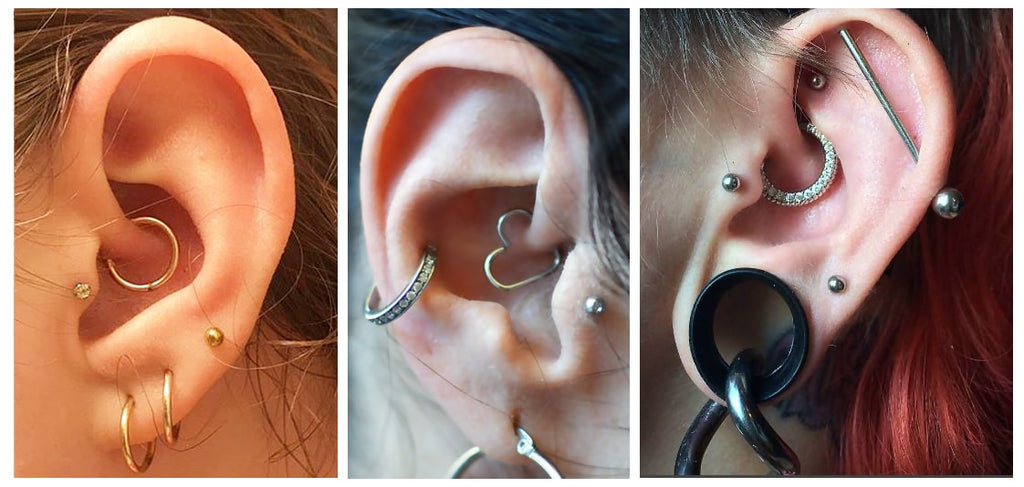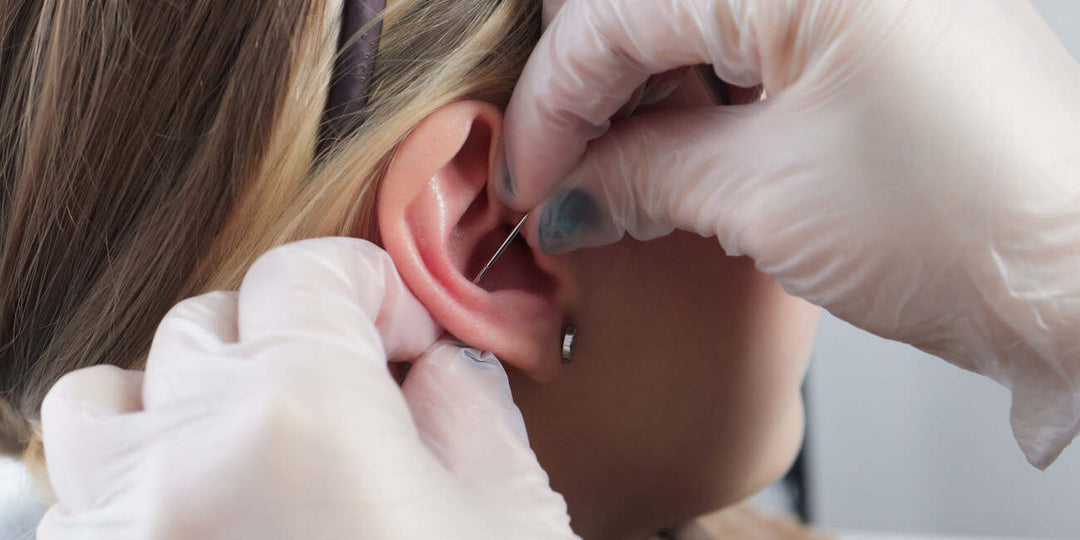The Daith Piercing: Everything You Need To Know


Permanently activating acupuncture points is a common trend in the piercing community. The idea is that a strategically placed piercing will generate the benefits of acupuncture points, potentially minimizing things like headaches, anxiety, and even weight gain. The most common piercing that believers of this practice turn to is the daith piercing.
What Is A Daith Piercing?
If you place your finger in your ear canal, you’ll feel a fold of cartilage sticking out above the passageway. Move your finger upward and pinch that flap of cartilage. That is your daith.
While cartilage piercings, in general, are becoming more and more popular, the daith in particular has seen recent traction. As more companies accept cartilage piercings as acceptable in the workplace, many are taking advantage of the unique piercings that the folds of the ear allow, such as the daith piercing.
Furthermore, the daith piercing is located in an area that’s fairly easy to hide. Unlike cartilage piercings that appear around the rim of the ear, like the helix or auricle piercings, this one is tucked away near your ear canal. Subtle jewelry items, like a seamless hoop, can go unnoticed in professional or conservative settings.
However, as with all cartilage piercings, the daith piercing takes a long time to heal. Due to its long healing time, it’s more susceptible to piercing complications, like piercing bumps that may form due to lazy aftercare practices or trauma to a healing piercing. Here’s everything you need to know about the daith piercing before getting one.
Daith Piercings For Migraines
Before we talk about the growing trend of piercings for medical purposes, we want to firmly note that this is a pseudoscience, and none of the below claims have any peer-reviewed scientific backing. Any claim made that piercings can ease any pain or aid in mental help are purely anecdotal. If you would like to get a daith piercing, don’t do so for the sole purpose to ease your migraines. Any minimization of pain should be a happy side effect of a super cute piercing, and we do not recommend getting pierced for any sort of medical or mental health cure.
Acupuncture is the practice of placing needles in strategic points in order to alleviate pain, improve mental health, or even lose weight. Those who partake in the practice on a spiritual level believe that the acupuncture needles affect your energy flow or "Chi" Medically, acupuncture stimulates the central nervous system, releasing chemicals that reduce pain and improve mental health.
The theory behind piercing acupuncture points is that the piercing itself will permanently activate these points. The daith piercing is located at an acupuncture point that is activated in order to reduce migraines. The idea is that, if you get your daith pierced, you should see a reduction in migraines.
While many have claimed that the daith piercing has helped reduce their migraine pain and appearance of migraines, most medical professionals agree that any reduced pain is the result of a placebo effect rather than any true medical benefit. Many who have experienced reduced migraine pain only saw results in the first few weeks after the piercing was done; migraine pain returned after a month or so. Because of this, the daith piercing should only be pursued as a potential migraine alleviator if the primary goal of the piercing is aesthetics and not medical treatment.
Daith Piercing Pain
Because the daith piercing appears in the cartilage, it’s considered one of the more painful piercings to get. However, most who have gotten this piercing have reported that it hurts less than they thought, considering the thickness of the cartilage in this area, and the greatest discomfort of the piercing came, not from the pain, but rather from the sound of the crunch as the needle punctures the thick cartilage close to the eardrum.
The thickness of the cartilage combined with its difficult-to-reach location makes it a challenging piercing. If you have a lower pain tolerance, you probably want to choose a more expensive piercer; they will be more confident in the process, leading to a more comfortable experience.
Daith Piercing Healing Time
On average, the daith piercing takes around 6 - 9 months to heal. Of course, it might take longer, depending on how your body heals. Have a piercer take a look at your piercing to make sure that it has fully healed, inside and out, before changing your jewelry or stopping aftercare practices. The daith piercing will appear fully healed before it is, and it’s not uncommon for piercees to damage their daith piercing due to ending aftercare practices early.
FreshTrends Tip
Clean your daith piercing twice a day using saline spray, to help speed up the healing process.
Aftercare
Since the daith piercing is a little difficult to access, it can be hard to keep the area clean. There are a few options for optimal cleaning, and you can choose the best one for you.
Use a piercing aftercare saline solution compress. Soak a paper towel with a piercing aftercare saline solution and hold the paper towel to your daith for 3 - 5 minutes. Once completed, you can pat the area dry with a paper towel or use the low setting on your hair dryer to blow it dry.
Use a piercing aftercare saline solution fine mist spray. To clean your daith in this way, simply spray each side of the daith piercing with the saline solution fine mist and let dry.
Don’t move the jewelry. Cartilage is more easily damaged than softer skin, so you need to be extra careful not to move your daith piercing jewelry as it heals. Damaged cartilage can lead to piercing bumps, jewelry rejection, and other issues. To avoid these complications, leave the jewelry alone. Furthermore, you want to make sure that you don’t put pressure on the piercing. Try not to sleep or lean against the piercing as it heals. This could pose a challenge, especially if you get both daiths done at the same time.
Don’t use earbuds as you’re healing. Earbuds will touch and move the jewelry, causing trauma to the piercing site that could lead to jewelry rejection or piercing bumps.
Keep any non-piercing product away from your piercing, including tea tree oil. The only product that you should use on your healing piercing is saline solution. Any other product contains chemicals that will irritate the piercing, leading to piercing bumps and other complications. It’s a common misconception that tea tree oil is good for your piercing, and even some piercing aftercare products contain tea tree oil. In fact, tea tree oil is quite caustic, in spite of its antimicrobial properties, and tea tree oil will irritate your piercing and potentially cause piercing bumps.
Stay away from standing water. This includes hot tubs, pools, lakes, baths, rivers, and oceans. Because the daith takes so long to heal, consider any upcoming vacations that may be impacted by your healing daith piercing.
Common Daith Piercing Side Effects
Side effects of a daith piercing are the same as any other piercing and can easily be avoided through proper aftercare practices. Make sure that you are wearing appropriate jewelry materials (titanium for your starter jewelry, then you can switch to a 14k gold piece after initial swelling has gone down), clean your piercing daily, keep your piercing safe from trauma, and avoid irritating chemicals, and your piercing should be just fine.
Common piercing side effects include:
- Piercing bumps: This is the most common side effect, especially in cartilage piercings. Bumps are usually either hypertrophic scars as the result of trauma, rashes from irritation, or pustules from poor hygiene. If a piercing bump appears, visit your piercer for diagnosis and treatment. The good news is that the vast majority of piercing bumps go away on their own with proper care.
- Piercing rejection: This happens usually after a massive trauma to the piercing, like a big snag. Signs of piercing rejection include red, flaky skin around the piercing site, a growing piercing hole, or noticeable movement of jewelry. If this happens, have a piercer take a look, but be aware that it likely means that you will have to let the piercing heal, and you can try to re-pierce it later.
- Piercing infection: While piercing infections are less common than you might think, they are important to note. Failure to treat a piercing infection could lead to serious medical side effects, so you must keep an eye out for infections and visit a doctor as soon as one is suspected. Signs of a piercing infection include bright yellow or green discharge coming from the piercing, excessive bleeding, excessive swelling, especially weeks after the initial piercing, a feverish feeling around the piercing, and development of a fever. A piercing infection is usually the result of very poor hygiene practices, but it’s good to keep an eye out for the signs, nonetheless.
A note on daith piercing keloids: A common misconception surrounding cartilage piercings is that keloids are something that commonly appear. While keloids can appear on a piercing, they are the result of a genetic disorder that affects only around 10% of the worldwide population. These bumps, which are a serious medical issue, appear as the result of any trauma, including small scratches or bug bites. If you have never grown a keloid before, or you don’t have a family history of keloids, then you are highly unlikely to develop a keloid.
Daith Piercing Cost
The cost of the daith piercing varies by location. In the US, you can expect to pay anywhere around $60 - $100, not including jewelry. It is a difficult piercing to conduct, and it can be a little uncomfortable, so you should choose your piercer based on experience rather than cost for the most enjoyable piercing experience.
How To Change A Daith Piercing
Once your daith piercing has fully healed, and your piercer has confirmed that this is true, it’s time to change out your daith jewelry for the first time. Those who have their daith pierced have said that it takes a few times to learn how to do it, so don’t get too frustrated if you’re unable to change your jewelry on your own at first. If you are struggling, visit your piercer to have them change it for you rather than potentially damaging the piercing site.
Related Products
View allWhat Type Of Jewelry Is Worn In A Daith Piercing?


The daith piercing accepts a variety of hoop and curved barbell options.
For initial jewelry, you’ll be fitted with a piece that’s slightly larger to accommodate swelling. Because your initial jewelry will only be worn for the first couple of weeks before being switched to the permanent piece, we recommend titanium for the starter piece. Titanium is inexpensive and contains few alloys, so it won’t irritate the skin. When you’re ready to switch to your more permanent piece, nickel-free 14k gold is the way to go. 14k gold contains as few alloys as possible while remaining durable enough to withstand daily wear and tear. Plus, it shines with a zeal that can’t be matched.
- Curved Barbells: They are among the most common jewelry types. To open, simply unscrew the internally threaded bead from one of the ends. To close, twist the bead back on until the bead is firmly in place. Do not screw too tightly to avoid stripping the threads.
- Clicker Rings: They are also very popular. Daith-specific clickers often have a flat prong, rather than a curved one, to allow the hoop to sit flush with your daith. To open and close a clicker ring, simply pop open the segment on one side and swinge it open on its hinge. Or, if you have a segment ring, simply pop the segmented piece out, insert the hoop into your daith piercing, then pop the segment back into place.
- Captive Bead Rings: Captive bead rings use a small bed to cover the hoop opening. To use, just pop out the bead and insert the jewelry into your piercing.
- Seamless Hoops Rings: For a subtler look, seamless hoops look super cute in a daith as well. These styles are more common with daith piercings that are a part of a cartilage cluster so that the daith jewelry doesn’t overwhelm the rest of the cartilage piercings. You will likely need a professional’s help changing these types of rings because they must be twisted open, and it’s difficult to do on your own with the daith piercing.










